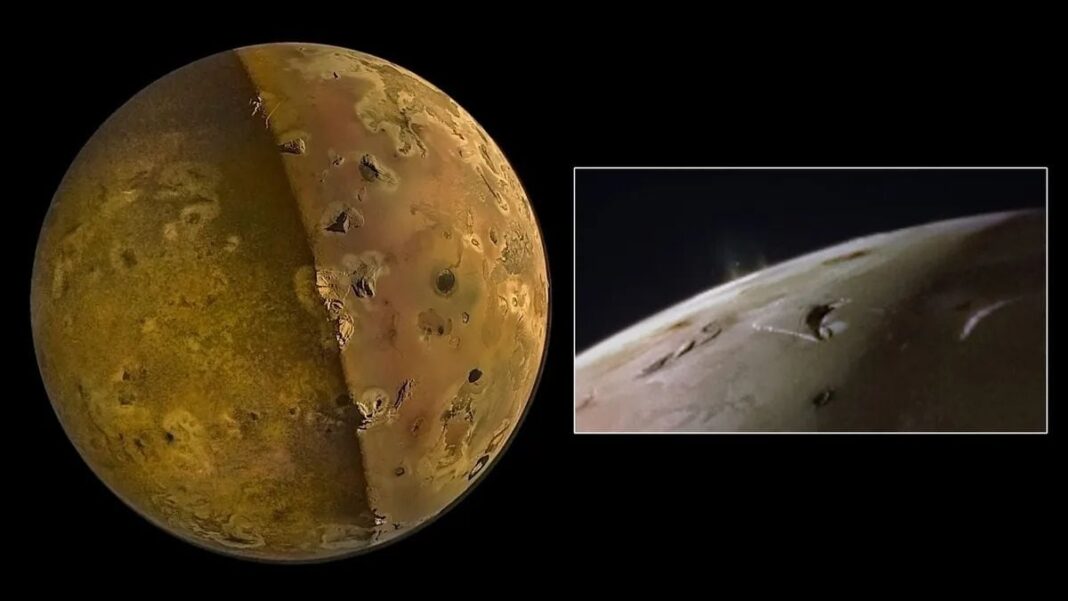Title: Unveiling the Mysteries of Io: Juno and Galileo Shed Light on Jupiter’s Moon
Recent research, published in Nature, has raised questions about the volcanic processes occurring on Jupiter’s moon Io, particularly regarding the absence of a global magma ocean beneath its surface. Data collected by NASA’s Juno spacecraft, combined with historical information from the Galileo mission, suggest that Io’s interior is more solid than previously believed. This revelation has implications not only for Io but also for our understanding of tidal heating in other celestial bodies.
The Story So Far:
Imagine a world where molten lava flows freely, where volcanoes dot the landscape like fiery sentinels, and where the very ground beneath your feet trembles with the power of celestial forces. This is the world of Io, Jupiter’s volcanic moon, a place of both awe-inspiring beauty and unfathomable mystery.
In a groundbreaking study, scientists led by Ryan Park from NASA’s Jet Propulsion Laboratory have delved into the heart of Io’s fiery core. Through a meticulous analysis of data gathered by Juno during its close fly-bys of Io, as well as insights from the Galileo mission, a startling discovery has been made – Io’s interior is not the seething cauldron of molten rock that was once believed.
Juno and Galileo Findings Reveal a Solid Interior:
Io’s Rigidity Unveiled:
- Scientists have uncovered that Io’s rigidity rules out the presence of a moon-wide ocean of molten rock. Previous theories had suggested the existence of such an ocean to explain the movement of heat beneath Io’s surface, but the latest findings have turned this notion on its head.
- Juno’s close observations, combined with data from Galileo, have provided a clearer picture of Io’s gravitational field and its response to Jupiter’s immense gravitational pull. This new understanding challenges our preconceptions and opens up a realm of possibilities in planetary science.
Source of Lava Remains Under Investigation:
Unravelling the Origins of Io’s Lava:
- With over 400 active volcanoes and vast lava plains, Io is a world in constant flux. The absence of a global magma ocean has led scientists to explore the idea of localized pockets of melt within the moon’s mantle as the source of this molten rock.
- These pockets, heated by the tidal forces exerted by Jupiter and its neighboring moons, offer a glimpse into the intricate dance of celestial bodies. The interplay of gravitational forces generates heat, shaping the very landscape of Io and challenging our perceptions of planetary geology.
Implications for Exoplanetary Studies:
Looking Beyond Io:
- The implications of Io’s solid interior extend far beyond the bounds of our solar system. Exoplanets in close orbits around M-dwarf stars, akin to Io’s relationship with Jupiter, are subject to tidal heating. The absence of a global magma ocean on Io prompts a reevaluation of our assumptions about these distant worlds.
- By revisiting our models and theories, we gain new insights into the complex interplay of forces that shape planetary bodies across the cosmos. Io’s revelations serve as a beacon, guiding us towards a deeper understanding of the universe that surrounds us.
Conclusion:
In the heart of the Jovian system, Io stands as a testament to the wonders and mysteries of our celestial neighborhood. The revelations brought forth by Juno and Galileo have unveiled a world of unexpected complexity and beauty, challenging our perceptions and inviting us to explore the depths of planetary science with renewed vigor.
Frequently Asked Questions:
- What did the recent research on Io reveal about its interior?
- The research unveiled that Io’s interior is more solid than previously believed, ruling out the presence of a global magma ocean.
- How did Juno and Galileo contribute to these findings?
- Juno’s close fly-bys of Io, alongside data from the Galileo mission, provided crucial insights into Io’s gravitational field and deformation under Jupiter’s pull.
- What implications does Io’s solid interior have for exoplanetary studies?
- The findings challenge assumptions about exoplanets in close orbits around M-dwarf stars, prompting a reevaluation of models related to tidal heating.
- What is the source of lava on Io without a global magma ocean?
- The lava on Io is believed to originate from localized pockets of melt within the moon’s mantle, heated by tidal forces from Jupiter and its neighboring moons.
- How many active volcanoes are estimated to be present on Io?
- Io is home to approximately 400 active volcanoes, scattered across its surface.
- What role do tidal forces play in generating heat on Io?
- Tidal forces exerted by Jupiter and its neighboring moons, Europa, Ganymede, and Callisto, generate heat through constant twisting and squeezing of Io’s interior.
- How does the absence of a global magma ocean on Io impact previous theories?
- The absence challenges previous assumptions that exoplanets in close orbits would host extensive molten layers, prompting a reassessment of these hypotheses.
- What key discoveries were made through Juno’s observations of Io’s gravitational field?
- Juno’s observations revealed the rigidity of Io’s interior, ruling out the possibility of a moon-wide ocean of molten rock.
- What new possibilities are opened up by the recent findings on Io’s interior?
- The findings open up new avenues for research in planetary science, offering fresh insights into the complex processes that shape celestial bodies.
- How do the revelations about Io’s interior challenge our understanding of planetary geology?
- The revelations challenge conventional ideas about the role of magma oceans in planetary bodies and prompt a reevaluation of our knowledge about volcanic processes in the solar system and beyond.
Tags: Jupiter, Moon Io, Juno spacecraft, Galileo mission, volcanic activity, tidal heating, planetary science, celestial bodies, exoplanets, magma ocean.
- The revelations challenge conventional ideas about the role of magma oceans in planetary bodies and prompt a reevaluation of our knowledge about volcanic processes in the solar system and beyond.
- What did the recent research on Io reveal about its interior?

